Defining the core of your business and projecting it to consumers is a difficult task. It requires an in depth analysis of your company, how it functions, and its dynamic.
These ten steps will help guide your thought process through each element of your business and provide a rubric to designing your brand identity.
Image Source: aumcore.com
Some of the most successful brands such as Disney, Starbucks, Mac and Levi's all have one thing in common: strong, recognizable features in their identity. Unique branding sets a business apart from competitors and draws in consumers like attracting bees to honey.
Creating a brand identity that supports the ideas and values of your business requires a lot of strategizing.
Whether you seek help from a web development agency or do it on your own, here are 10 creative steps to help your business along its journey to self-discovery.
1. Define the Purpose
Ask yourself the question your English teacher inquired about everyday in high school, "why?" Why should consumers care? What sets your products or services apart from everything else available in the market?
Begin with the basics and gain a deeper understanding as to what your company stands for. Are you constantly in demand? Will customers head to your doors during their leisure time?
Think about how your business is a solution to a particular problem or need and prepare to promote those benefits of your products or services around those principles.
2. Understand the Target Market
Who are they? How does your business service them? Part of creating a defining identity for your brand stems from understanding your consumers.
Remember they are your foundation and they need to feel your brand is recognizable, familiar, and most importantly trustworthy.
A study by the Edelman Trust Barometer shows 80% of people will buy products from a company they trust.
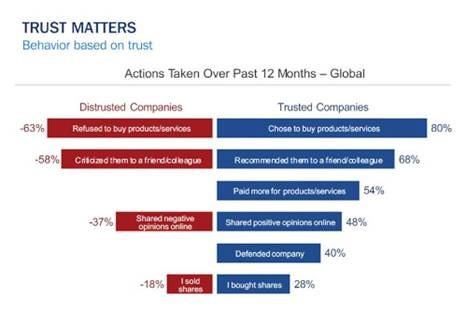
Image Source: altimetergroup.com
By creating a customer-centric identity that shows your business cares about its audience and by integrating that into what your company represents, consumers will be more likely to purchase your product.
3. Design a Strong Logo
Your logo is a symbolic representation of your business. Everything from colors to styling tells a story about what your company stands for. It will be the ultimate face of the brand, so think carefully and don't be afraid to update it when necessary.
Over the years, many famous logos have been altered to appeal to modern markets. Let's take a look at the progression of Starbucks' siren logo for example:
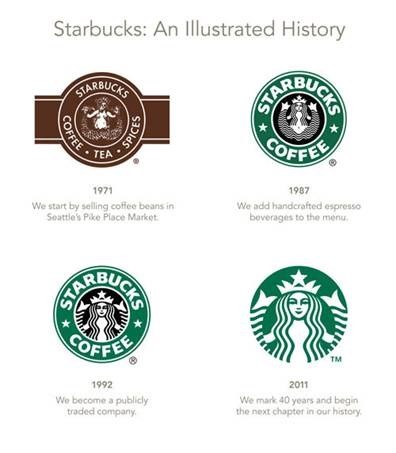
Image source: logodesignlove.com
Each symbol was adapted to appear more modern but multiple elements remain true to the original logo from 1971.
Keeping a core aesthetic is vital but remember to think about what's relevant now.
Remember to keep in mind these questions: what is the aesthetic preference of the day? Something simple and sleek? Maybe something more three-dimensional? Black and white or vibrant colors?
Learn how your target audience has evolved, and make moderate shifts accordingly. Create something individual and true to your company, while also keeping your audience in mind.
See Also: 10 Best Websites to Get Inspiration for Logo Designing Online
See Also: Top 10 Custom Logo Design Service Providers
4. Create Supporting Visuals
In addition to your logo, what other visuals define your brand? Do you have a particular color scheme or font in mind? Do you have a mascot like Geico's gecko? A jingle or slogan?
Explore your options because you might find one medium more beneficial than the next. Printed designs for business cards or fliers may prove beneficial to supporting brand identity. Video marketing has helped various campaigns go viral and in turn, those brands.
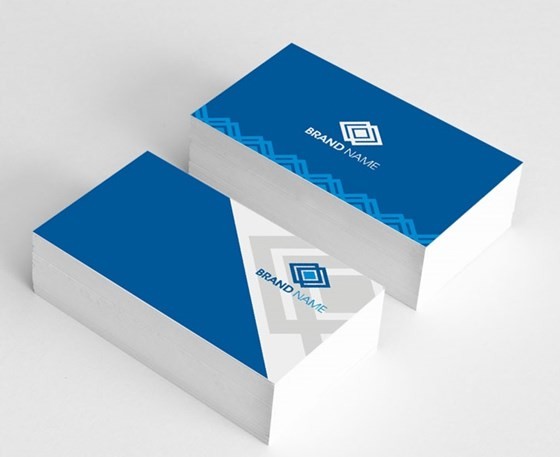
Ask yourself, what can you achieve on your end, to make your business recognizable? If you need assistance, 360° marketing agencies like Aumcore can help you with anything from identity conceptualization to web design services.
5. Determine the Voice
What does your brand's voice sound like? How will you come across on social media? What writing choices will you make stylistically?
Determining how your brand communicates is a large part of your brand's identity. Is your brand intellectual or maybe something a little more comedic? Let's take a look at how two of America's favorite pizza companies approach twitter.
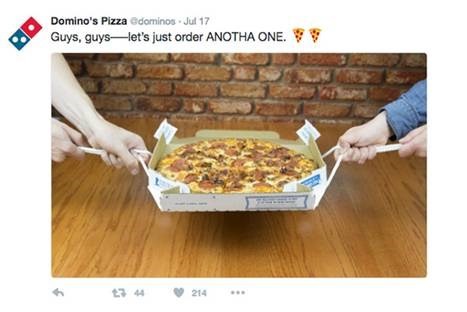

Domino's makes a play on DJ Khaled's trending quote while Pizza Hut uses more descriptive language. Both companies serve pizza, but their Twitter pages have completely different voices.
Domino's is a lot more playful and utilizes trending topics familiar to teenagers and young adults, whereas Pizza Hut's Twitter page features more family friendly language.
Choose what highlights the essence of your company. When your brand speaks, how do you want consumers to react to the information?
Communication is all about understanding. Just as you're trying to understand your audience, they're trying to understand you.
See Also: Learn How Social Media Activity Promotes Your Business SEO Activities
6. Identify the Corporate Image
Does your company require a specific corporate identity? Decide whether it would be more beneficial to separate the product from the corporate brand or stick with the rules already in place.
For some brands, a united front and styling is most effective, so determine what makes sense for your market.
Some companies find an independent corporate image necessary because they want distance from their product's branding. If this is the case, there are components to your mission statement as noted by Business Insider that are needed.
Your mission statement must have details about your specific audience, your company's purpose, and what unique solution your products or services provide.
7. Infuse Company Culture
Would your office be located on 5th Ave. in midtown Manhattan or would you rather be based in SoHo with a renovated studio? Same island, but each neighborhood speaks to completely different types of people.
If you're a brick and mortar store, select where your brand fits in the best, but also think about the customers and your employees.
Can your workers walk into the office in jeans and a t-shirt or is it formalwear at all times? Developing a strong brand identity also requires having a solid internal dynamic.
Much of that has to do with your employees because they are the living, breathing examples of your company's culture. One company that does an excellent job with this is Google.

Image source: blog.kissmetrics.com
With an intensive interview process and selection method, Google only passes those who prove themselves as innovators.
With such strong abilities, this company recognizes the worth of its employees and treats them accordingly with unmatched benefits. Their offices alone push boundaries by offering creative environments that break the traditional model and encourage interaction. They have consistently placed at the top of the ‘best companies to work for' list and continuously show how a solid company culture results in business success.
8. Project a Leadership Mentality
Creating a well-rounded cast of characters who are dedicated to progression and innovation starts with great leaders. Establishing an environment that fosters creativity needs leaders to set up the business parameters.
Long ago, Disney abolished the silo work culture and adopted a dynamic, more accepting form of communication between and across channels. This shift in thinking now results in $45 billion in revenue.
However, that adjustment would have never occurred if the leadership didn't believe the company needed to change.
Look out for your business, for your workers, and most importantly for what keeps your company unique. All of those choices stem from quality leadership.
9. Understand the Essence
Describe your company in one word. That essence should be present in all aspects of your business from aesthetic choices to human characteristics.
Your brand identity design goes beyond labels, slogans, and colors, because at the receiving end of all advertisements and interactions is a human consumer. When they make a connection and develop an opinion about your brand's identity, ensure it's positive and reflects the strengths of your company.
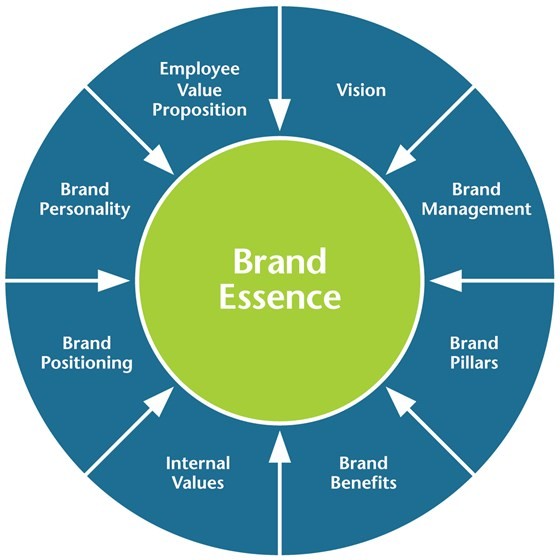
A brand bio incorporating key words and a strong recap of other identity features is a great tool for keeping your entire company on point.
10. Know the Statistics
After you have developed and implemented your company's brand identity, what are the facts? How has integration helped or harmed your business?
Look at the differences in engagement and sales. If you see a negative trend, maybe more work needs to be done. If the effects are positive, continue on the path you have chosen. Stay grounded by taking an approach that is results driven.
When developing and finalizing your company's identity keep in mind it's an ongoing process. Just as logos adapt to fit the times, you will find yourself re-positioning your business over and over again.
Stay flexible because what worked back in the 1990's won't necessarily produce successful results today. Your brand identity requires much more thought and strategizing than just a couple weeks, really dedicate time to discovering the ins and outs of your business.
Be creative and keep an open mind, inspiration can be drawn from everywhere.